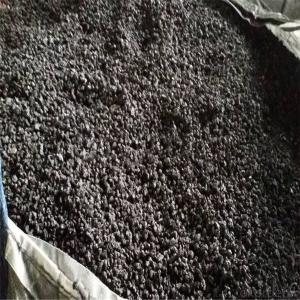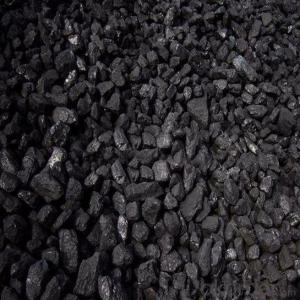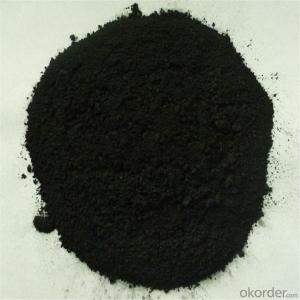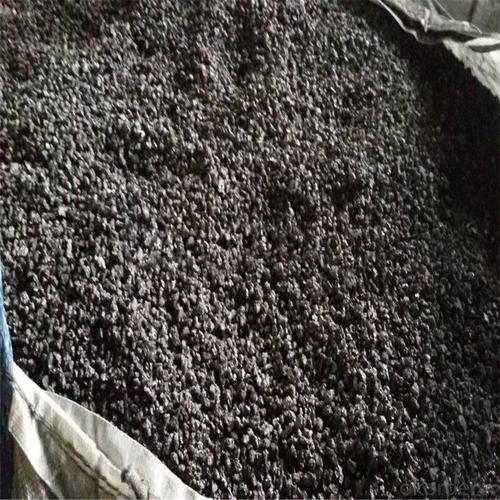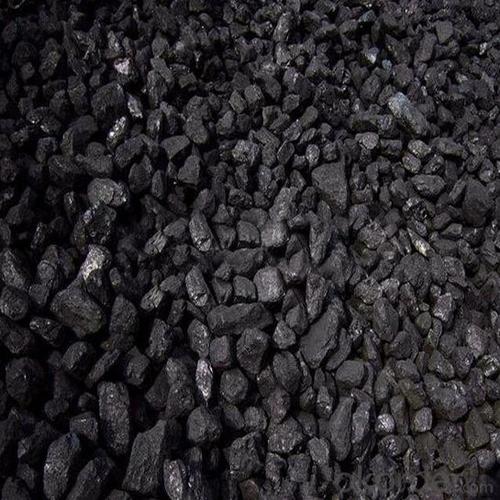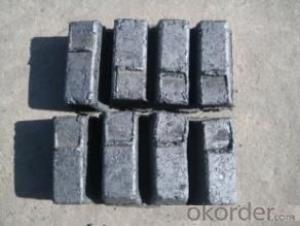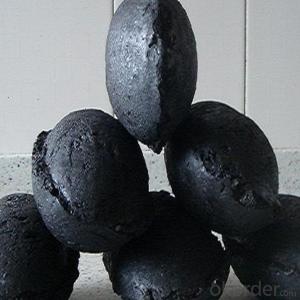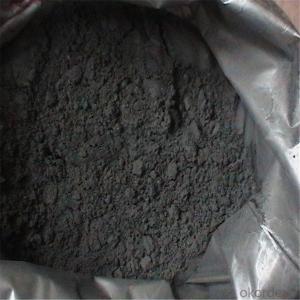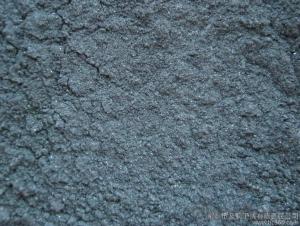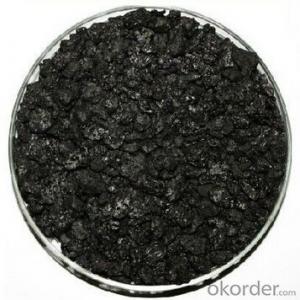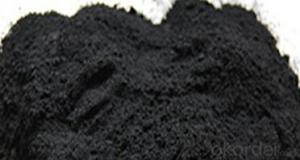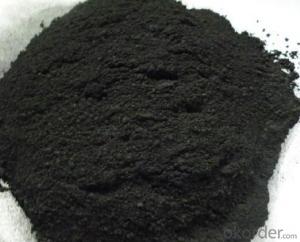Natural graphite graphite paint/carbon raiser recarburizer
- Loading Port:
- Dalian
- Payment Terms:
- TT OR LC
- Min Order Qty:
- 10 m.t
- Supply Capability:
- 500000 m.t/month
OKorder Service Pledge
OKorder Financial Service
You Might Also Like
Specifications of Carbon Raiser:
Carbon raiser:
- F.C is 90-95% min
- 6-10mm,sulfur0.2% min
- Be made of Ningxia anthracite
- High absorptivity
Quick Details:
Place of Origin: Dalian China (Mainland) | Brand Name: ShengSa | Model Number: SSGCA |
Application: Foundry;Metallurgy | Dimensions: High-carbon | Chemical Composition: C ; S ; V ; ASH |
C Content (%): 93%min | S Content (%): 0.3%max | Ash Content (%): 6%max |
Vol . Matter: 1.5%max | Moisture content: 0.8%max | Size: as per customer's requirement |
Color: Black |
Packaging & Delivery:
Packaging Detail: | a.1 mt super bags. b.1 mt super bags on pallets. c.25kgs small bags on 1 mt super bags. d.25kgs small bags on 1 mt super bags on pallets. e.as per customers' requirement. |
Delivery Detail: | within 25 days against the down payment |
Gas Calcined Anthracite/GCA
Fixed carbon | 95%min |
Ash content | 4%max |
Vol . Matter | 1.2%max |
Sulphur content | 0.25%max |
Moisture content | 0.5%max |
Size | As per customers' requirement |
packing | 25kg paper bag on the pallet or 10kg paper bag shrieked wrapped on the pallet or 1MT big bag or other packing as required |
delivery time | 20days or depends on the order quantity |
Supply ability | 8000 Metric Ton/Metric Tons / Month |
Payment terms | L/C at sight or T/T |
Size: 1-4mm, 1-5mm, 3-8mm, 8-20mm (as per customers’ requirement)
Usage: Gas Calcined Anthracite/GCA is carbon raiser, widely used in steel-making, metallurgical
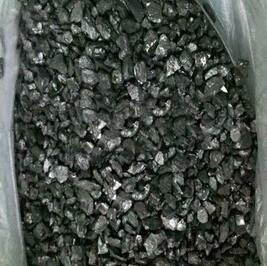

- Q: How is carbon used in the production of paints and pigments?
- Carbon is widely used in the production of paints and pigments due to its unique properties and versatility. One of the primary ways carbon is utilized is through the production of carbon black. Carbon black is a fine powder made from the incomplete combustion of hydrocarbons, such as coal tar, petroleum, or natural gas. It is extensively used as a pigment in various types of paints, inks, and coatings. The dark color of carbon black makes it a popular choice for providing intense black pigmentation in paints and pigments. It is highly stable and resistant to fading, which ensures that the color remains vibrant over time. Additionally, carbon black has excellent opacity, allowing it to cover other colors effectively and create a solid base for further pigmentation. Carbon black also enhances the durability and performance of paints and coatings. It acts as a reinforcing agent, improving the mechanical properties of the final product. It increases the strength, toughness, and resistance to abrasion, making the paint or coating more long-lasting and resistant to wear and tear. Furthermore, carbon black is an electrically conductive material. This property makes it a valuable component in a wide range of specialty coatings, including anti-static coatings and electromagnetic shielding coatings. These coatings are used in various industries, such as electronics, automotive, and aerospace, where electrical conductivity or protection against electromagnetic interference is critical. Apart from carbon black, other forms of carbon, such as graphite and carbon nanotubes, are also used in the production of specialized paints and pigments. Graphite is commonly used in high-performance coatings due to its lubricating properties and resistance to extreme temperatures. Carbon nanotubes, on the other hand, offer unique optical, electrical, and mechanical properties, making them suitable for advanced coatings and pigments in various applications. In summary, carbon plays a crucial role in the production of paints and pigments by providing intense black pigmentation, enhancing durability, and offering unique properties for specialized coatings. Its versatility makes it a valuable ingredient in the paint and pigment industry, ensuring the production of high-quality, long-lasting, and visually appealing products.
- Q: What are the properties of carbon-based textiles?
- Carbon-based textiles offer several distinct advantages in different applications. To begin with, they demonstrate exceptional strength and durability. Renowned for their high tensile strength, carbon-based textiles can resist stretching and tearing, enabling them to withstand harsh conditions and maintain their integrity over time. Moreover, these textiles possess excellent thermal conductivity, efficiently managing heat. This quality proves beneficial in industries like aerospace, automotive, and electronics, where effective heat dissipation is crucial to prevent system failures. Additionally, carbon textiles exhibit remarkable resistance to chemical corrosion, remaining structurally intact even when exposed to various chemicals, acids, and solvents. This resistance makes them ideal for applications in the chemical industry, where contact with corrosive substances is common. Another notable attribute of carbon textiles is their inherent flame resistance. They possess a high resistance to ignition and do not easily propagate flames. Consequently, they find use in environments where fire safety is paramount, such as protective clothing for firefighters and military personnel. Furthermore, carbon-based textiles display good electrical conductivity, making them suitable for electronics and electrical engineering applications. They effectively conduct electricity and dissipate static charges, reducing the risk of electrical malfunctions or damage. Lastly, carbon textiles have a low coefficient of thermal expansion, meaning they undergo minimal expansion or contraction with temperature changes. This property ensures their dimensional stability, guaranteeing that they maintain their shape and size under varying thermal conditions. In conclusion, carbon-based textiles possess a combination of strength, durability, thermal conductivity, chemical resistance, flame resistance, electrical conductivity, and dimensional stability. These properties render them highly versatile and suitable for a wide range of applications across various industries.
- Q: What is carbon neutral manufacturing?
- Carbon neutral manufacturing refers to the process of manufacturing goods while minimizing or offsetting the carbon emissions associated with the production. It involves reducing greenhouse gas emissions at every stage of the manufacturing process, from sourcing raw materials to the disposal of finished products. This can be achieved through various measures such as energy efficiency, the use of renewable energy sources, implementing sustainable practices, and investing in carbon offset projects. To become carbon neutral, manufacturers typically start by conducting a detailed assessment of their carbon footprint, which involves identifying and quantifying all the emissions generated in their operations. This includes direct emissions from manufacturing processes, as well as indirect emissions from the energy sources they use. Once the emissions are measured, manufacturers can develop strategies to reduce their carbon footprint. Some common methods of achieving carbon neutrality in manufacturing include optimizing energy consumption by using efficient equipment and technologies, adopting renewable energy sources like solar or wind power, and implementing waste reduction and recycling programs. Additionally, manufacturers can invest in carbon offset projects, which are initiatives that reduce or remove greenhouse gas emissions from the atmosphere, such as reforestation or renewable energy projects. By implementing these measures and offsetting any remaining emissions, manufacturers can achieve carbon neutrality. This not only helps combat climate change by reducing the overall carbon footprint but also demonstrates a commitment to sustainability and environmental responsibility. Carbon neutral manufacturing is an important step towards transitioning to a low-carbon economy and creating a more sustainable future.
- Q: What is carbon black filler?
- Carbon black filler, a commonly utilized additive in the production of rubber and plastic products, is derived from the incomplete combustion of hydrocarbons, such as oil or natural gas. It takes the form of a fine, powdery substance and is primarily composed of elemental carbon, with trace amounts of hydrogen, oxygen, and sulfur. The primary objective of incorporating carbon black filler is to enhance the physical characteristics of rubber and plastic materials. Its addition improves the strength, durability, and wear resistance of the final product. Furthermore, carbon black filler increases the material's stiffness and hardness, making it suitable for various applications. Beyond its mechanical properties, carbon black filler offers additional advantages. It acts as a reinforcing agent, augmenting the tensile strength and tear resistance of rubber compounds. Additionally, it heightens the material's electrical conductivity, proving valuable in scenarios where static electricity dissipation is necessary. Moreover, carbon black filler safeguards the material against the detrimental effects of UV radiation and ozone. It serves as a UV stabilizer and antioxidant, preventing degradation and extending the product's lifespan. Furthermore, carbon black filler enhances the thermal conductivity of rubber and plastic materials, facilitating heat dissipation. Overall, carbon black filler is a versatile and extensively employed additive in the manufacturing industry. Its distinctive attributes render it an indispensable component in the production of various rubber and plastic products, including tires, conveyor belts, hoses, gaskets, among others.
- Q: What is carbon footprint labeling?
- The system of carbon footprint labeling provides consumers with information regarding the carbon emissions associated with a product or service. Its purpose is to educate consumers on the environmental impact of their purchases and empower them to make more sustainable choices. Typically, this labeling includes a measurement of the greenhouse gas emissions generated throughout the entire life cycle of a product, encompassing its production, transportation, and disposal. Consequently, consumers are able to compare the carbon footprints of various products and make well-informed decisions based on their environmental values. Carbon footprint labeling plays a vital role in promoting sustainability and urging businesses to reduce their emissions. Furthermore, it raises awareness about the influence that individual consumption choices have on climate change and encourages a transition towards more environmentally friendly alternatives.
- Q: What are the different types of carbon-based alloys?
- There are several different types of carbon-based alloys, each with unique properties and applications. Some of the most common types include: 1. High carbon steel: This type of alloy contains a high percentage of carbon, typically between 0.6% and 1.5%. It is known for its strength and hardness, making it suitable for applications such as tools, knives, and automotive parts. 2. Low carbon steel: Also known as mild steel, this alloy has a lower carbon content, usually below 0.3%. It is more malleable and ductile than high carbon steel, making it suitable for applications that require forming and welding, such as construction and automotive components. 3. Stainless steel: A popular alloy that contains chromium, nickel, and other elements, stainless steel is highly resistant to corrosion and staining. It is commonly used in kitchen utensils, medical equipment, and construction. 4. Cast iron: This alloy contains a higher carbon content, typically between 2% and 4%. It is known for its excellent heat retention and is commonly used in cookware, pipes, and engine blocks. 5. Tool steel: Designed for making cutting tools, this alloy has a high carbon content, typically between 0.7% and 1.4%. It offers excellent hardness, wear resistance, and heat resistance. 6. Carbon fiber reinforced polymers (CFRP): These alloys consist of carbon fibers embedded in a polymer matrix. They are lightweight, strong, and have high stiffness, making them ideal for applications such as aerospace, sports equipment, and automotive parts. Overall, carbon-based alloys offer a wide range of properties and applications, making them versatile materials in various industries.
- Q: What are the impacts of carbon emissions on the stability of tundra ecosystems?
- The stability of tundra ecosystems is significantly and extensively affected by carbon emissions. Greenhouse gases like carbon dioxide and methane, which are emitted into the atmosphere, contribute to global warming and climate change. Consequently, tundra ecosystems, which are particularly susceptible to temperature fluctuations, suffer various adverse consequences. To begin with, increased carbon emissions result in higher temperatures, leading to the thawing of permafrost in the tundra. Permafrost, which is permanently frozen soil, serves as the foundation for the tundra ecosystem. Its thawing compromises the stability of the entire ecosystem, rendering the ground unstable and causing landscapes to collapse, landslides to occur, and drainage patterns to be altered. This disruption negatively affects the habitats of plants and animals, as well as the distribution of water resources. Moreover, as permafrost thaws, organic matter that has been frozen for thousands of years begins to decompose. This decomposition process releases substantial amounts of carbon dioxide and methane into the atmosphere, intensifying the greenhouse effect. This feedback loop accelerates climate change and contributes to the overall increase in carbon emissions. Furthermore, the thawing of permafrost also impacts the vegetation in tundra ecosystems. Many plant species in the tundra rely on the stability and availability of nutrients provided by the permafrost layer. With its degradation, plants encounter difficulties in establishing and maintaining their root systems. This subsequently reduces plant productivity and alters the composition of plant communities. Changes in vegetation can have consequences for wildlife, such as reindeer, caribou, and migratory birds, which depend on specific plant species for sustenance and shelter. Additionally, the increased thawing of permafrost releases previously trapped pollutants and contaminants, which further jeopardize the stability of tundra ecosystems. These pollutants, including heavy metals and toxic chemicals, can enter waterways and disrupt the delicate balance of the ecosystem, impacting aquatic life. In conclusion, carbon emissions contribute to the destabilization of tundra ecosystems through the thawing of permafrost, alteration of vegetation, release of greenhouse gases, and contamination of water resources. These impacts not only affect the unique biodiversity of the tundra but also have implications for global climate change. It is crucial to reduce carbon emissions and mitigate the effects of climate change to preserve the stability and integrity of these fragile ecosystems.
- Q: Can carbon in barbecue cause cancer? Can carbonated food cause cancer?
- It will be。WHO published 3 years of research results, said barbecue foods produce carcinogenic substances are toxic, "eat barbecue, equivalent to smoking."". A US research center report even said eating a roast chicken leg is equivalent to the toxicity of 60 cigarettes; women who eat barbecue are 2 times more likely to develop breast cancer than other women.
- Q: What is carbon dating?
- Carbon dating is a scientific method used to determine the age of ancient artifacts or fossils by measuring the amount of carbon-14 remaining in them.
- Q: How does carbon affect the color of gemstones?
- Carbon can affect the color of gemstones by either enhancing or modifying their natural hues. When present as impurities or inclusions, carbon can give gemstones a yellow or brown color. However, when arranged in a specific crystal lattice, carbon can create exceptional colorless or white gemstones, such as diamonds.
Send your message to us
Natural graphite graphite paint/carbon raiser recarburizer
- Loading Port:
- Dalian
- Payment Terms:
- TT OR LC
- Min Order Qty:
- 10 m.t
- Supply Capability:
- 500000 m.t/month
OKorder Service Pledge
OKorder Financial Service
Similar products
Hot products
Hot Searches
Related keywords
